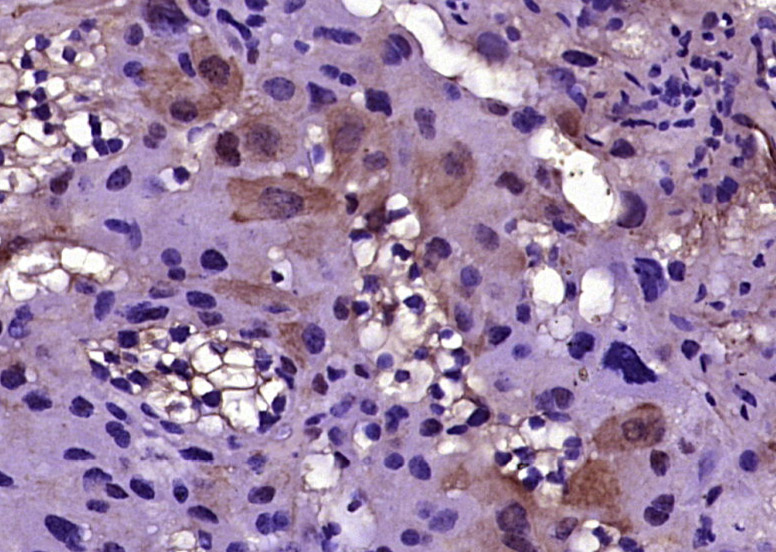
Rabbit Anti-NAP2 antibody
B TG1; Beta TG; b-TG1; beta-TG; NAP-2; NAP2; NAP 2; Beta thromboglobulin; Chemokine (C X C motif) ligand 7; Connective tissue activating peptide III; CTAP 3; CTAP III; CTAP3; CTAPIII; CXC chemokine ligand 7; CXCL 7; CXCL7; LA PF 4; LA-PF4; LDGF; Leukocyte
View History [Clear]
Details
Product Name NAP2 Chinese Name 中性粒细胞活性蛋白2/血小板碱性蛋白抗体 Alias B TG1; Beta TG; b-TG1; beta-TG; NAP-2; NAP2; NAP 2; Beta thromboglobulin; Chemokine (C X C motif) ligand 7; Connective tissue activating peptide III; CTAP 3; CTAP III; CTAP3; CTAPIII; CXC chemokine ligand 7; CXCL 7; CXCL7; LA PF 4; LA-PF4; LDGF; Leukocyte derived growth factor; Low affinity platelet factor IV; MDGF; NAP 2; NAP-2; NAP 2 L1; Neutrophil activating peptide 2; PBP; Platelet basic protein; Platelet basic protein precursor; PPBP; Pro platelet basic protein; SCYB7; Small inducible cytokine B7; Small inducible cytokine subfamily B member 7; TC1; TC2; TGB; TGB1; THBGB; THBGB1; Thrombocidin 1; Thrombocidin 2; Thromboglobulin beta 1. Research Area Cardiovascular Cell biology immunology Signal transduction Growth factors and hormones Immunogen Species Rabbit Clonality Polyclonal React Species Mouse, (predicted: Rat, ) Applications ELISA=1:5000-10000 IHC-P=1:100-500 IHC-F=1:100-500 ICC=1:100-500 IF=1:100-500 (Paraffin sections need antigen repair)
not yet tested in other applications.
optimal dilutions/concentrations should be determined by the end user.Theoretical molecular weight 14kDa Cellular localization Secretory protein Form Liquid Concentration 1mg/ml immunogen KLH conjugated synthetic peptide derived from mouse NAP2: 1-80/130 Lsotype IgG Purification affinity purified by Protein A Buffer Solution 0.01M TBS(pH7.4) with 1% BSA, 0.03% Proclin300 and 50% Glycerol. Storage Shipped at 4℃. Store at -20 °C for one year. Avoid repeated freeze/thaw cycles. Attention This product as supplied is intended for research use only, not for use in human, therapeutic or diagnostic applications. PubMed PubMed Product Detail The protein encoded by this gene is a platelet-derived growth factor that belongs to the CXC chemokine family. This growth factor is a potent chemoattractant and activator of neutrophils. It has been shown to stimulate various cellular processes including DNA synthesis, mitosis, glycolysis, intracellular cAMP accumulation, prostaglandin E2 secretion, and synthesis of hyaluronic acid and sulfated glycosaminoglycan. It also stimulates the formation and secretion of plasminogen activator by synovial cells. [provided by RefSeq, May 2010].
Function:
LA-PF4 stimulates DNA synthesis, mitosis, glycolysis, intracellular cAMP accumulation, prostaglandin E2 secretion, and synthesis of hyaluronic acid and sulfated glycosaminoglycan. It also stimulates the formation and secretion of plasminogen activator by human synovial cells. NAP-2 is a ligand for CXCR1 and CXCR2, and NAP-2, NAP-2(73), NAP-2(74), NAP-2(1-66), and most potent NAP-2(1-63) are chemoattractants and activators for neutrophils. TC-1 and TC-2 are antibacterial proteins, in vitro released from activated platelet alpha-granules. CTAP-III(1-81) is more potent than CTAP-III desensitize chemokine-induced neutrophil activation.
Subunit:
Beta-thromboglobulin is a homotetramer.
Subcellular Location:
Secreted.
Post-translational modifications:
Proteolytic removal of residues 1-9 produces the active peptide connective tissue-activating peptide III (CTAP-III) (low-affinity platelet factor IV (LA-PF4)).
Proteolytic removal of residues 1-13 produces the active peptide beta-thromboglobulin, which is released from platelets along with platelet factor 4 and platelet-derived growth factor. NAP-2(1-66) is produced by proteolytical processing, probably after secretion by leukocytes other than neutrophils.
NAP-2(73) and NAP-2(74) seem not be produced by proteolytical processing of secreted precursors but are released in an active form from platelets.
Similarity:
Belongs to the intercrine alpha (chemokine CxC) family.
SWISS:
N/A
Gene ID:
57349
Database links:Entrez Gene: 5473 Human
Entrez Gene: 57349 Mouse
Omim: 121010 Human
SwissProt: P02775 Human
Unigene: 2164 Human
Product Picture
Bought notes(bought amounts latest0)
No one bought this product
User Comment(Total0User Comment Num)
- No comment



 +86 571 56623320
+86 571 56623320
 +86 18668110335
+86 18668110335

